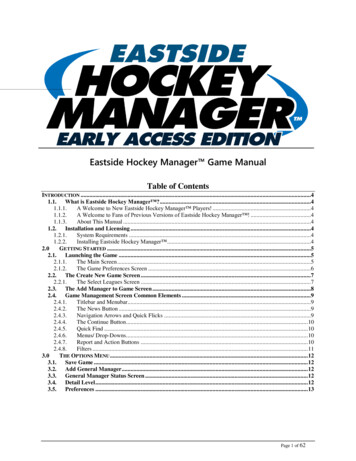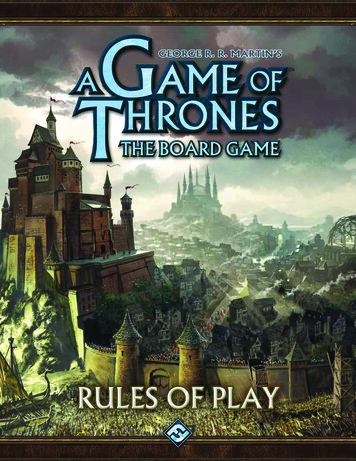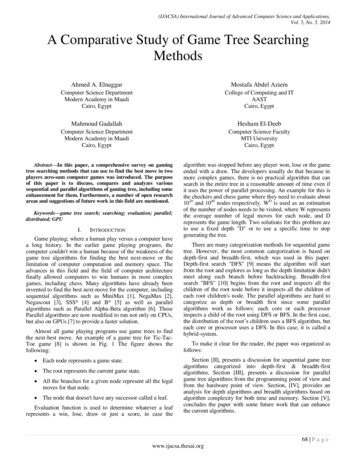
Transcription
Board Game Studies JournalISSN opuscula.orgEditorial BoardJorge Nuno Silva(managing editor)University of Lisbonjnsilva@cal.berkeley.eduAlex de VoogtMuseum of Natural HistoryNY, USAadevoogt@amnh.orgCarlos P. SantosCELCcps.carlos@gmail.comFernanda FrazãoApenas Livrosfernandarbfrazao@gmail.comIrving FinkelBritish Museumcuneatics@aol.comJoão Pedro NetoUniversity of Lisbonjpn@di.fc.ul.ptLídia FernandesMuseu Romanocapitulidia@gmail.comThierry DepaulisLe Vieux Papierthierry.depaulis@free.frUlrich SchädlerMusée Suisse du Jeuu.schaedler@museedujeu.chSupporting InstitutionsAssociação Ludusludus@ludicum.orgCentro Inter-Universitário deHistória da Ciência e da Tecnologia(CIUHCT)Published byAssociação LudusR. da Escola Politécnica, 561250-102 LisboaPORTUGALTypeset in LATEX
ARTICLESRussian four-handed chess: myths andmisconceptionsGeorgi MarkovNational Museum of Natural History, SofiaAbstract: The only comprehensive and reliable descriptions of four-handedfortress chess were published in 1850 and 1862 by the Russian master A.D. Petrov, who had first-hand experience with the game. An earlier sourceomits numerous details regarding the rules; later sources digesting Petrov’sdescription contain misconceptions and outright mistakes. The article attempts to refute the errors accumulated in the literature and accentuate thefew minor points in the rules left uncovered by Petrov. An adaptation of thefour-handed game for two players is provided.Keywords: Four-handed chess; chess history; chess variantsIntroductionIn 1850, Schachzeitung published a comprehensive description of four-handedfortress chess by the Russian master Alexander Petrov, translated in German by Carl Jaenisch (Petroff (1850)). Twelve years later, a nearly identicaltext in Russian appeared in Shakhmatny Listok (Petrov (1862)). Fortresschess had been mentioned in literature before: in his O shakhmatnoi igre,the first Russian chess manual, Butrimov (1821) provided a brief account ofthe game and a sketch of the board but did not go into detail.Fortress chess was apparently known at least as early as the beginningof the 19th century but its origins are shrouded in mystery. In the late 18thcentury, Coxe (1784) reported that “Russians have also another method ofplaying at chess, namely, with four persons at the same time, two againsttwo; and for this purpose the board is longer than usual, contains more men,and is provided with a greater number of squares”: this might or mightnot relate to the game described by Butrimov and Petrov. The editorialfollowing Petrov’s 1862 text (pp. 185–187) which quotes his letter to thejournal says that, according to Petrov’s grandfather, this chess variant usedto be played by Catherine the Great (1729–1796).Board Game Studies Journal online 9, pp. 41–49bgsj.ludus-opuscula.org
42Russian four-handed chess: myths and misconceptionsThe two articles by Petrov are the only detailed descriptions by an author having a first-hand experience with the game. Later sources, while ultimately based on Petrov’s evidence, have added inaccuracies and outrightmistakes. Below, I will attempt to provide a synopsis of what is actuallyknown about four-handed fortress chess, draw attention to the few detailsconcerning the rules that remain unknown, and refute some of the misconceptions that have accumulated in the century and a half following Petrov’spublications.RulesGame played on a board with 192 squares: a 128-squares four-handed chessboard as used in some German variants (with four 2x8 rows on each side ofa normal chess board) enhanced with four 4x4 fortresses in the corners (Figure 1). All kings are on the right; each player has an extra rook, bishop andknight, positioned randomly (contra Machatscheck (1987)) in their fortress.Partners sit opposite each other, move clockwise. Pieces move and captureas in FIDE chess, with one detail to be kept in mind: since the fortresswalls are impenetrable for all pieces, the knight’s move needs a precise definition. From the description by (Petroff, 1850, p. 379), it is obvious thatthe knight’s move was understood as one square orthogonally and one diagonally in any order; i.e. not L-shaped but also not necessarily orthogonallyfirst as in xiangqi or janggi, contra (Pritchard, 2007, p. 324). [Incidentally,this is exactly the way that the knight’s move is described in some Russian literature of that period: the 1843 Pravila shakhmatnoi igry by “V.D.”, a loose translation of Krupski’s Strategika szachowa (Anonymous-V.D.(1843)), or the 1869 Russian translation of Neumann’s Leifaden für Anfängerim Schachspiel (Anonymous (1869))]. Needless to say, the precise definitionof the knight’s move is only relevant when negotiating the fortress wall.The wall was represented by a simple line in Petroff (1850) and Petrov(1862), who mentioned that it should be made “a finger high”. Glyazer(1962) and Machatscheck (1987) provide a more elaborate structure butthis seems to be an invention — probably Glyazer’s, or his illustrator’s (cf.the fanciful depictions of xiangqi and shogi boards for example). Accordingto (Machatscheck, 1987, p. 64), a board is kept at the Russian Chess Museum in Moscow; my repeated attempts to contact the museum and obtaininformation on the actual look of the board have been fruitless.Board Game Studies Journal online 9, pp. 41–49bgsj.ludus-opuscula.org
Georgi Markov43The aim of the game is to checkmate both opponents. A mated player’spieces are removed from the board. [Petrov is explicit on that point, comparing fortress chess to the “German game” (without fortresses) where matedpieces are left immobile on the board and the player passes turns until themate is lifted — which Petrov found “illogical” and “completely against thespirit of chess”. Later sources, however, provide a clear example of Chinese whispers: in a brief entry on fortress chess, Glyazer (1962), speaking offour-handed chess variants in general, mentioned the different treatment ofmated pieces in the Russian and “western European” games; Machatscheck(1987), clearly relying on but misunderstanding Glyazer’s text, spoke of twodifferent ways of playing fortress chess: “Russian”, with mated pieces removed, and “west European”, with pieces remaining on the board. Thelatter, though, seems to have never existed].It seems obvious that if the remaining solitary opponent was stalematedthe game was a draw. What is not clear is what happened if a player wasstalemated with his partner still in play. There are two theoretical possibilities — either the stalemated player passed turns, similar to west Europeanfour-player variants, or the game was immediately declared a draw. There isno way to know with certainty which was the case but I feel that the secondoption — an immediate draw — would be more consistent with the spiritand logic of Russian fortress chess.Yet another detail which is not entirely clear concerns pawn promotion.Petrov says that a pawn is promoted to any piece when reaching the homerank of either the opponents or the ally. What he doesn’t explicitly mentionis what would happen to a pawn that has entered a fortress by capturing(a situation that, admittedly, must have occurred rarely in actual play, ifat all). Perhaps in that case one should take Petrov’s description literallyand forbid promotion on any square apart from c5-c12, o5-o12, e3-m3, ore14-m14. Indeed, this would leave a pawn reaching the last rank in a fortressimmobile and useless — but so would a move by e.g. White e11xd12.Speaking of pawns, Petrov clearly said that allied pawns meeting on thesame file blocked each other’s way (see also Pritchard (2007)) so Machatscheck(1987) is obviously wrong in his assertion that allied pawns (and pieces!)could leap over each other.Board Game Studies Journal online 9, pp. 41–49bgsj.ludus-opuscula.org
44Russian four-handed chess: myths and misconceptionsFigure 1: Four-handed fortress chess, initial position with pieces in the fortressesplaced at random. Modified after Butrimov (1821), Petroff (1850) and Petrov(1862). Note that diagonals touching fortress walls or board angles (e.g. n2-m3,n4-m5, or m4-n5) are forbidden.PlayPetrov briefly discussed the actual play, suggesting a few useful openingmoves. From his description, it is evident that — in his time at least —the queen in fortress chess had the usual FIDE move, even though Coxe(1784) reported earlier that Russians played (two-handed) chess with thequeen having “in addition to the other moves, that of the knight”. Thiscustom was apparently losing ground in the following decades, with the firstRussian chess manuals promoting the modern moves: (Butrimov, 1821, p.26), wrote that “some, in addition to these moves, allow it to move as aknight as well” but advised against it, his entire book being written withthe FIDE-like queen move in mind, and (Petrov, 1824, p. 35) was rathercategorical: “the queen moves in all ways except as a knight”.Board Game Studies Journal online 9, pp. 41–49bgsj.ludus-opuscula.org
Georgi Markov45In his 1850 Schachzeitung article, Petrov had observed that by the endof the game, a solitary knight or bishop could mate the opponents’ barekings, adding that “such cases are very entertaining”. (Verney, 1885, p.74)apparently failed to realize that this is only possible with the two allied kingsoperating together, and re-interpreted Petrov’s original comment as “If atthe end of the game a King is left with only a Bishop and a Knight, evenif he has no Pawns, he could checkmate his adversaries’ Kings if they hadno Pieces left”. (Understandably, the “very entertaining” comment was leftout).(Pritchard, 2007, pp. 324–325) says that “sometimes Fortress Chess wasplayed with the Ks on the left of the Qs, a harder game since it increased thedifficulty of removing the king from danger”. More precisely, in a footnote,(Petroff, 1850, p. 378) advised against playing this way: in his opinion,castling long decreased chances of moving the king into the fortress andgave white too much of advantage.Game popularityIt was by readers’ requests that Shakhmatny Listok published the rules offortress chess, so the game must hardly have been a well-known pastime.Indeed, Petrov’s letter to the journal states that four-handed fortress chesswas not particularly popular, with only a few players in St. Petersburg(I. Butrimov being among the five listed). It’s impossible to know if the18th century four-handed game mentioned by Coxe was the same as theone described by Butrimov and later Petrov; thus, we can only guess if thelimited knowledge of fortress chess in Petrov’s time was because this was agame once more common but becoming obsolete, or because it was neverparticularly widespread anyway.Machatscheck (1987), followed by Pritchard (2007) claimed that Russianfortress chess spread in the west, and that in 1855 there was a London clubespecially devoted to the game. This is certainly a mistake, Machatscheckonce more misreading Glyazer (1962). What (Glyazer, 1962, p. 32) says isthat four-handed chess (in general, not the fortress variant) was spread in“many countries of Europe, Asia and America” (which might be an overstatement), adding that in 1885 (note the correct date) there was a club inLondon dedicated to four-handed chess. This obviously refers to the London Four-handed Chess Club presided by G. H. Verney which had its firstmeeting in 1885, playing after Verney’s rules initially and later after thosemodified by M. E. Hughes-Hughes.Board Game Studies Journal online 9, pp. 41–49bgsj.ludus-opuscula.org
46Russian four-handed chess: myths and misconceptionsSummary and conclusionsTwo mid-19th century articles by A. Petrov are the only reliable descriptionsof four-handed fortress chess, providing a thorough explanation of the rulesand leaving out only a few fine points which probably occurred only rarelyin actual play. Butrimov’s 1821 brief account is valuable as an independentsource predating Petrov’s publication in Schachzeitung by nearly thirty years(one might recall that Lange (1856) seemed to believe that Petrov was describing a newly invented variant) but the information therein is insufficientto actually play the game. Later sources, while ultimately based on Petrov,omit — or invent — various details, creating some confusion about the rulesof a rather enjoyable game.Appendix 1Four-handed chess variants, or at least those played in Europe, have beenmet with anything from keen enthusiasm to open scorn. Petrov’s descriptions of fortress chess raised mostly mild interest, several mentionings inlater literature and then oblivion — in my opinion, undeserved. I tend toagree with Petrov that this variant, with its simple rules and logic closerto the traditional two-handed game, is indeed more playable than the rest.Also, I find the idea of fortresses and extra pieces rather charming, and toogood to be confined to a four-handed game only. Below, I suggest a versionof fortress chess modified for two players (designed in 2011). The resultinggame is both “new” (in terms of theory studies) and quite familiar, withno new pieces, moves or rules to memorize. Indeed, as in the original fourhanded game, one should keep in mind the definition of the knight’s moveas not L-shaped:Two-handed fortress chessTwo-handed fortress chess is played on a board with 96 squares (8x8 plustwo fortresses of 4x4 each: Figure 2). Each player has the usual 16 pieces oforthochess, plus an additional rook, bishop and knight placed at will insidethe fortress. Pieces can enter and leave the fortress only through its gate:moving horizontally along the third and fourth (or ninth and tenth) ranks,or diagonally along the l1-b10 (b3-l12) or h3-i4 (i9-h10) diagonals. Thisnecessitates defining the knight’s move: as in four-handed Russian fortresschess, it consists of one diagonal and one orthogonal step in any order: aknight on i3 can move to g4 (via h3 or h4) and to h5 (via h4: diagonal stepBoard Game Studies Journal online 9, pp. 41–49bgsj.ludus-opuscula.org
Georgi Markov47is first), and from i4 to g3 (via h3 or h4) or g5 (via h4: orthogonal step isfirst) but not to h6 (because of the fortress wall, the diagonal step to h5 isimpossible, and the knight’s move is not L-shaped). Pawns are promotedon the opponent’s home rank (rows 3 and 10) outside the fortresses, or onthe farthest rank inside the fortress, row 1 or 12.Figure 2: Two-handed fortress chess.Appendix 2Moving the fortresses towards the middle results in an almost identical gameon a more compact 12x8 board (designed in 2012):Two-handed fortress chess IIIn this variant, the position of the fortresses is changed to fit a 12x8 board(Figure 3). Same rules apply, including the knight’s move, pieces enter andleave the fortresses by moving horizontally along the first, second, seventhand eighth ranks, or diagonally along the h1-l4, i1-b8, b1-i8, or h8-l5 diagonals. Pawns are promoted on the opponent’s home rank (rows 1 and 8)outside as well as inside the fortress.Board Game Studies Journal online 9, pp. 41–49bgsj.ludus-opuscula.org
48Russian four-handed chess: myths and misconceptionsBoth two-handed variants can be played without the extra pieces, resulting in games that are slightly different tactically.Figure 3: Two-handed fortress chess II.AcknowledgementsHeinz Machatscheck’s Zug Um Zug, its drawbacks notwithstanding, openedto me the world of chess variants in the 1980s. This paper would nothave been possible without a number of sources freely available online — atGoogle Books, the Internet Archive, and the John and Sue Beasley WebSite(who generously uploaded the revised edition of Pritchard’s Encyclopedia).My father, Ninko Markov, enthusiastically helped trying out the fortresschess variants. I thank Vladimir Parfenov (Ulyanovsk) for his time andpatience with my questions on Russian fortress chess.Dr. Georgi N. MarkovNational Museum of Natural History — BAS1 Tzar Osvoboditel Blvd., 1000 SofiaBulgariamarkov@nmnhs.comReceived on June 1, 2015, accepted on September 16, 2015.Board Game Studies Journal online 9, pp. 41–49bgsj.ludus-opuscula.org
Georgi Markov49ReferencesAnonymous (1869). Shakhmatnaya igra. Teoreticheskoe i prakticheskoerukovodstvo G. R. Neimana. St. Petersburg. In Russian; 186 pp.; atranslation of Neumann (1865).Anonymous-V.D. (1843). Pravila shakhmatnoi igry. St. Petersburg. InRussian; 148 pp.; a loose translation of Krupski (1835).Butrimov, I. (1821). O shakhmatnoi igre. St. Petersburg. In Russian; 214pp.Coxe, W. (1784).Dublin. 499 pp.Travels into Poland, Russia, Sweden and Denmark.Glyazer, S. (1962). Delu — vremya, potehe — chas. Molodaya gvardiya,Moscow. In Russian; 64 pp.Krupski, K. (1835). Strategika szachowa. Warsaw. 300 pp.Lange, M. (1856). Lehrbuch des Schachspiels. Halle, Schroedel & Simon.272 pp.Machatscheck, H. (1987). Zug um Zug. Die Zauberwelt der Brettspiele. NeuesLeben, Berlin, 5th revised edition. 192 pp.Neumann, G. (1865). Leitfaden für Anfänger im Schachspiel. Springer,Berlin. 96 pp.Petroff, A. (1850). Das Vierschach mit Festungen. Schachzeitung, 5:377–384.Petrov, A. (1824). Shakhmatnaya igra. St. Petersburg. In Russian. Parts I& II. 166 pp.Petrov, A. (1862). Kratkoe opisanie chetvernoi shakhmatnoi igry s krepostiami. Shakhmatnyi Listok, 44:181–185. In Russian; editorial on pp.185–187.Pritchard, D. (2007). The Classified Encyclopedia of Chess Variants. JohnBeasley, 2nd revised edition. 384 pp. Edited and published by JohnBeasley.Verney, G. (1885). Chess Eccentricities. Longmans, Green, & Co., London.200 pp.Board Game Studies Journal online 9, pp. 41–49bgsj.ludus-opuscula.org
Board Games Studies was first published in 1998, an initiative inspiredby the colloquia on board games held at Leiden University, the Netherlands,in 1995 and 1997. Five institutions affiliated themselves with the journal:the Institut für Spielforschung und Spielpädagogik in Salzburg, the International Institute for Asian Studies in Leiden, the Russian Chess Museum inMoscow, the British Museum in London, and the Department of ComputerScience at the University of Maastricht. The journal, which was publishedby CNWS Publications in Leiden on a yearly basis, was partially fundedthrough the assistance of patrons and boasted a modern layout, trilingualsummaries and color plates. The broad ambition of this journal requireda continuous commitment from the editors, who reviewed contributions inGerman, French and English, provided translations of summaries for eacharticle and, in several cases, collaborated extensively with authors to developmanuscripts that were to the academic standards of the publication. Thejournal had a trial run of three years, after which the format, content andreview process was evaluated. The authors of the articles integrated wideranging literature necessary for a comprehensive understanding of particular games. Contributions from different disciplines — including psychology,computer science, philology, classical archaeology and history — allowed fora better historical and systematic understanding of board games to emerge.Starting in 2000, a section with a translation of primary sources was added.Book reviews and research notes further complemented the multi-facettedcontents. Its first ambition, to serve as a platform for the publication ofboard games research, was met quickly, while gradually the journal gainedprominence among researchers by publishing seminal historical overviews.The colloquia continued from 1995 onwards, moving from a biennial to ayearly schedule. The host institution was expanded beyond Leiden to universities and museums throughout Europe as well as Jerusalem, Philadelphiaand, in 2013, the Azores. The colloquia continue to gather an enthusiasticgroup of scholars, players and collectors. Despite the institutional affiliationsand a group of patrons, the production of the journal became financially andlogistically problematic with CNWS no longer able to serve as a publisher.Reluctantly, the paper version of the journal was discontinued after volume7 was published in 2004. The possibility of an online version of the journalhad been explored with the online publication of the first issues, a decisionthat greatly assisted the dissemination of knowledge accumulated in thoseearly volumes. The next step, an online journal that operates again as aplatform for recent board games research, was not far away but required theskills and enthusiasm of previous and new editors to materialize. In theselast fifteen years, the study of board games has gained momentum and thisjournal will not only showcase new results but, most of all, will encourageand publicize the work of the dedicated researchers in this field.Alex de Voogt
To the authorsBoard Game Studies is an academic journal for historical and systematicresearch on board games. Its object is to provide a forum for board gamesresearch from all academic disciplines in order to further our understanding ofthe development and distribution of board games within an interdisciplinaryacademic context. Articles are accepted in English, French, and Germanand will be refereed by at least two editors under the final responsibility ofthe Editorial Board. Please send your contributions in any editable format(Word, LATEX, rtf, . . . ) with a matching PDF file. Please send all theillustrations in separate files.Send all mail to the managing editor:Jorge Nuno SilvaHistória e Filosofia da CiênciaFaculdade de CiênciasCampo Grande, C41749-016 LisboaPORTUGALContactsAssociação LudusBoard Game Studies JournalR. da Escola Politécnica, 561250-102 LisboaPORTUGALemail: bgsj@ludus-opuscula.orgURL: bgsj.ludus-opuscula.org
Russian chess manuals promoting the modern moves: (Butrimov, 1821, p. 26), wrote that \some, in addition to these moves, allow it to move as a knight as well" but advised against it, his entire book being written with the FIDE-like queen move in mind, and (Petrov, 1824, p. 35) was rather categorical: \the queen moves in all ways except as a .










